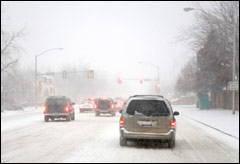Dear Umbra,
Is there a relationship between air quality and temperature? I thought about this on my bike ride to work this morning when the smell of exhaust from cars seemed more potent, and the fumes were certainly more visible in the 32-degree air. I know that air quality in Los Angeles is worse during the summer. And “code red” or “code orange” air quality days occur in the summer in Washington, D.C., and in Richmond. But I have heard that in really cold places like Fairbanks, Alaska, where people leave their cars running while doing errands, the air quality is worse in the winter.
Mary Reynolds
Richmond, Va.
Dearest Mary,
What biking inspiration! Neither rain, nor sleet, etc. Good for you.

Can weather chill pollution levels?
Photo: iStockphoto
There is indeed a relationship between air quality and temperature. We tend to think of smoggy skies as a summertime problem, because sunlight plays a key role in forming ozone — and maybe because there are more hours of daylight for smog-gazing. But air quality suffers in winter too, for a number of reasons. These reasons have less to do with geography than with weather patterns and human behavior.
Let’s back up for a moment. Air pollutants are produced by cars, power plants, forest fires, metal processing plants, dusty roads, construction sites, woodstoves … I’m trying to make a long list, but most air pollutants come from vehicles and power generation. By far. Particulate matter is the pollutant that adds a little diversity to our list of sources, because it rises from construction sites and chimneys. Lead makes our list diverse, too; now that gasoline is unleaded in the U.S., the main domestic sources of airborne lead are businesses that process metals. But our compounds of chief concern spew from cars and power plants: nitrogen oxides, the precursors to ground-level ozone formation; sulfur dioxide, a main ingredient in acid rain; and carbon monoxide, which directly messes with the human body.
So pollution is emitted from cars and burning of fuels and wafts through the air. Air quality, in turn, depends on how wafty the air is, and this is where the weather comes in. When air is stagnant, pollutants will lurk. Perhaps they come from far away and reach a stagnant spot and loiter there, perhaps on your bike route they stagnate directly behind the emitting cars.
The air can be stagnant due to lack of wind. But in winter, pollution is often trapped during inversions — that is, when a layer of warm air lies atop a layer of cold air. Until this arrangement is ended, the convection that normally carries away pollutants will not occur, and air quality plummets, especially if the area under an inversion includes many vehicles or power plants. By midmorning, the sun will generally warm the layer of air down where we humans are, causing the polluted air to expand and the contaminants to disperse. But I’m guessing that your bike commute takes place earlier than that, which means you may be riding through a wintry haze.
Another thing that can make pollution worse in winter — and this is something you should be aware of, given your commuting proximity to tailpipes — is that cold weather can keep car emissions control systems from being as effective as they should be, leading to higher carbon monoxide levels in the air. Add an inversion, and whammo: you’re in a soup of CO.
A third part of this equation is human behavior. When temperatures drop, people use their cars differently (idling them to warm them up, for instance) and crank up their woodstoves. Many cities, including Fairbanks but also those with less extreme winters, issue advisories and tips for cutting down on cold-weather pollution, for everyone from construction workers to drivers. These tips include reducing or eliminating wood burning, weatherizing your home to create less of a need for heating with wood, avoiding letting your car idle longer than 30 seconds, and — my favorite, always — driving less.
Your local weatherpeople probably issue an air-quality alert or index number on a regular basis. They should be able to tell you more if you wish to further investigate this phenomenon.
Coughily,
Umbra


